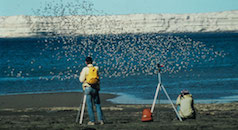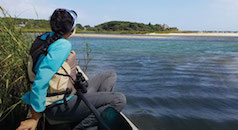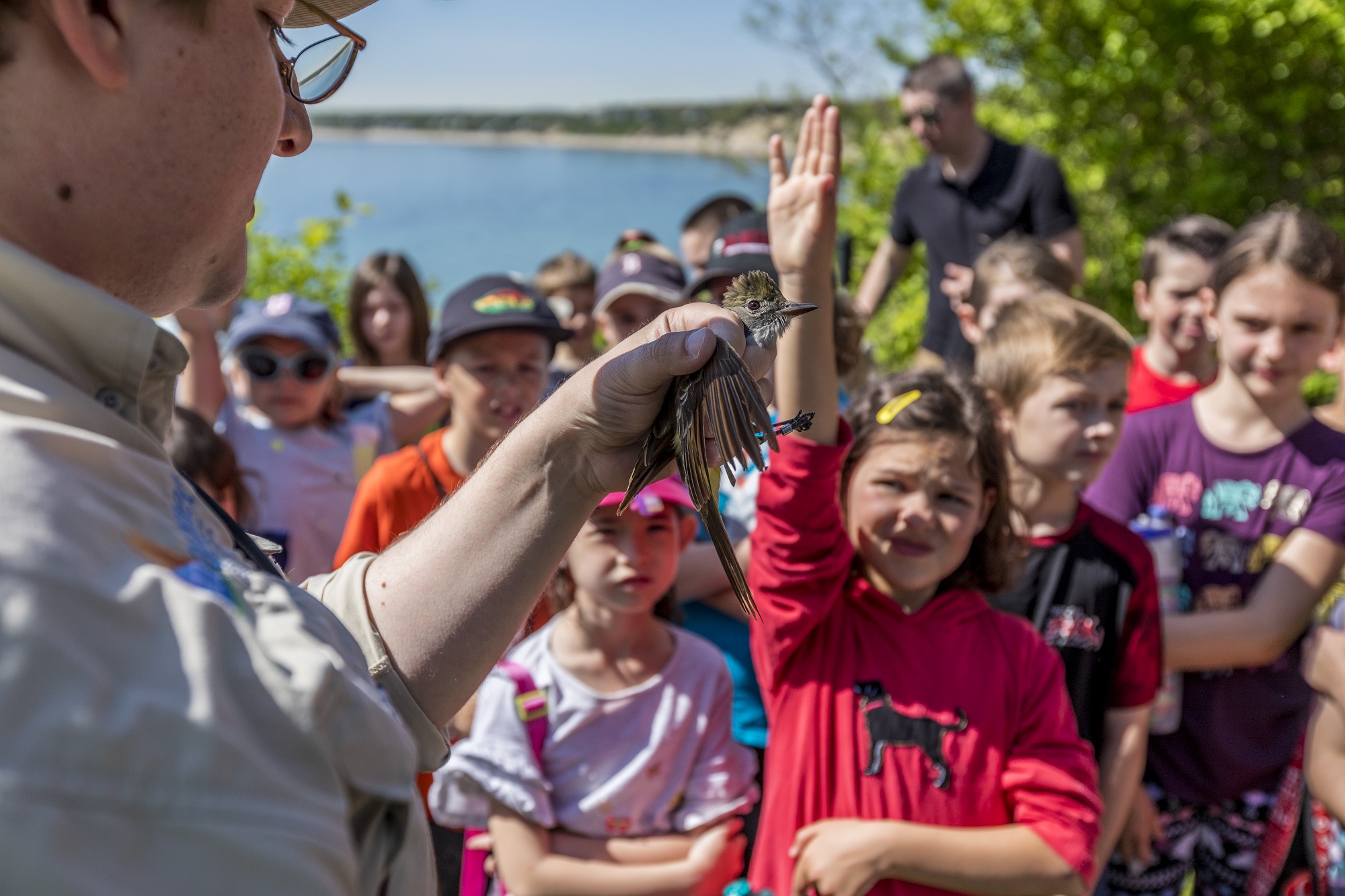Search Results

Restoring sea run fish to the Gulf of Maine
On a recent sunny Saturday, a crowd of 300 people enjoyed the spectacle of alewives making their way up a tributary of the Bagaduce River to Pierce’s Pond in Penobscot, a community on the shores of Maine’s Penobscot Bay. Kids and adults alike marveled at the powerful instinct that drives the fish to work their way upstream, surmounting each rise against the flow of the stream as it tumbles down to the sea. Students from the local middle school waded in the stream for a close up look at the fish, listening as their teacher explained the life cycle of alewives, a sea run fish that lives in the ocean and spawns in freshwater. Ospreys and eagles circled overhead, keeping...
Our busiest Arctic field season ever!
Every spring Manomet’s Shorebird Recovery Program prepares to launch field expeditions to shorebird breeding habitats in the arctic, but we’ve rarely had as exciting and ambitious plans as we do this year. Over the years, Manomet has conducted many different research projects across the North American Arctic, but usually just one major project at a time. This spring we are returning to the Arctic National Wildlife Refuge and will be conducting our busiest field season ever, with three projects underway at the same time. Our first project is to conduct a shorebird population survey of the entire 1002 Area, the disputed area recently opened to oil and gas exploration and potential development. Recent legislation that opened up this area to...
Monitoring waterbirds and wetlands in Central America
How do we know if a species is in decline, or if an important site is threatened? Monitoring—long-term, repeated data collection—is the foundation for managing and understanding species and the sites they depend upon. With this in mind, for the past three years, Manomet, through the WHSRN Executive Office, has overseen coordination of the Central American Waterbird Census. This census, launched in July 2011, is a regional component of the International Waterbird Census, coordinated globally by Wetlands International since 1967. The Central American Census was started by the Waterbird Conservation Council (in collaboration with Wetlands International and BirdLife International) in response to a gap in geographic coverage of regular waterbird monitoring and the interest of Environment Canada and the US...
Engaging Caribbean Conservationists in a Shorebird Training Workshop in Puerto Rico
“The workshop was one of the best I ever attended. I was very impressed with the vast knowledge that Manomet and BirdsCaribbean has accumulated and also the way you transfer this knowledge to workshop participants. It was very valuable for me and allowed me to deal with some conservation hurdles I am facing especially regarding how important water level management is for the birds.” - Binkie van Es with the Sint Maarten Nature Foundation shares his impression of the Conserving Caribbean Shorebirds and Their Habitats International Training Workshop hosted by Manomet and BirdsCaribbean in partnership with local NGO Sociedad Ornitológica Puertorriqueña (SOPI). The workshop took place at the Cabo Rojo National Wildlife Refuge in Puerto Rico from February 11 – 15, 2019. This...
All Abuzz in Patagonia and Tierra del Fuego
November in southern Patagonia and Tierra del Fuego is a buzzing blend of breeding and nonbreeding shorebirds. For South American shorebirds like Least Seedsnipe (Thinocorus rumicivorus), Rufous-chested Dotterel (Charadrius modestus), and Magellanic Oystercatcher (Haematopus leucopodus), the breeding season is in full swing. Birds are looking sharp in peak breeding plumage and there is an abundance of territorial behavior. Least Seedsnipe sing and perform flight displays in attempts to court a mate, or they sit atop fence posts to keep a watchful eye. Male Rufous-chested Dotterels aggressively chase each other in and out of disputed territories. Magellanic Oystercatchers elaborately distract us away from nearby nests with tail-flagging displays (Miller and Baker 1980). And Magellanic Plover (Pluvianellus socialis), the small, gray, dove-like...
How eating sea bass and crab can help Maine lobstermen
By learning about New England's diverse ecosystem and by eating the fish and shellfish that are adapting to our warming waters, you can help keep the Gulf of Maine and New England’s fishing communities thriving in the face of change. In the Portland Press Herald, Marissa McMahan shares about Manomet’s research into one of those ‘upcoming’ species, black sea bass.
The Mammals of Manomet
By Alan Kneidel Winter is often thought of as the dormant season—leaves wither, birds fly south, and amphibians sink into their winter hibernation. While this is certainly true in the Northeast, there is still no shortage of animal activity in the winter months, as long as you know where, and how, to look. This winter, we at Manomet took it upon ourselves to explore the winter wildlife at our headquarters property in Plymouth. What was our strategy? Let cameras do the work for us. Off and on throughout the winter, we strategically placed motion-activated trail cameras throughout the property. We chose locations that appeared to be logical wildlife thoroughfares, whether an easily accessible spot to fresh water or an unobstructed path through...
Caribbean Conservationists Excited to Conserve Shorebirds After Training Workshop in Puerto Rico
“I honestly finally feel like I can tackle shorebirds, with some level of comfort and confidence. I am so excited to get back out and practice!” Natalya Lawrence, a program officer at the Environmental Awareness Group in Antigua, had just returned from an International Training Workshop on Conserving Caribbean Shorebirds and Their Habitats. She was excited by her rich experience at the workshop, which was hosted by BirdsCaribbean and Manomet in partnership with local NGO Sociedad Ornitológica Puertorriqueña (SOPI). The workshop took place at the Cabo Rojo National Wildlife Refuge in Puerto Rico, February 11 – 15, 2019. The lessons, developed by BirdsCaribbean and Manomet’s Habitats for Shorebirds Project, help local leaders protect shorebirds in the Caribbean. Shorebirds, including sandpipers, plovers,...
Adapting to the warming Gulf of Maine
Fishing in the Gulf of Maine generates nearly $4 billion each year and provides as many as 100,000 jobs. This economy is threatened if we don’t understand how to adapt to the changes in species brought on by the warming Gulf of Maine. Manomet fisheries scientists Marissa McMahon, Anne Hayden, and Ethel Wilkerson will represent Manomet at the Maine Fishermen’s Forum in Rockport, Maine, from February 28 through March 2. This annual event is the largest gathering of fishermen, scientists, and policymakers in New England and a great place to showcase our work to sustain fish and fishing livelihoods in a changing Gulf of Maine. Marissa, Anne and Ethel will share information on Manomet’s clam farm work, black sea bass research, and...
A Planet of Hope: How Manomet and its for-profit partners are creating a sustainable 21st century
Meet the unexpected and unsung heroes creating a world where we can all thrive For 50 years, Manomet has been working to build a more sustainable world—for birds, for people, and for our planet. We believe that the for-profit sector is the key to this more sustainable world. It’s big, it moves fast, and it’s filled with people and organizations who are committed to solving the sustainability challenges facing us today. Join us on Thursday, September 26 to spend an evening with our insightful for-profit partners, like Cabot Creamery, Hannaford Supermarkets, Lyme Timber, the Massachusetts Food Association, UBS, and more, enjoying delicious sustainable food and drinks. We are proud to announce our guest speakers for the evening: Jimmy Bullock, Senior...



